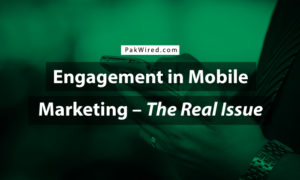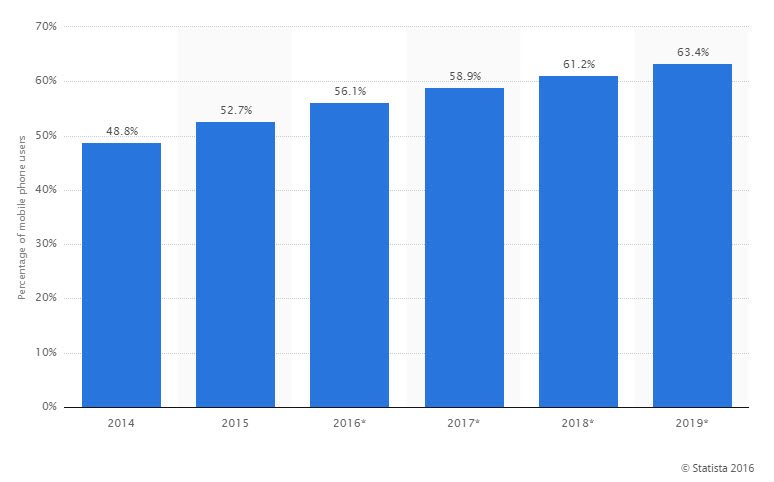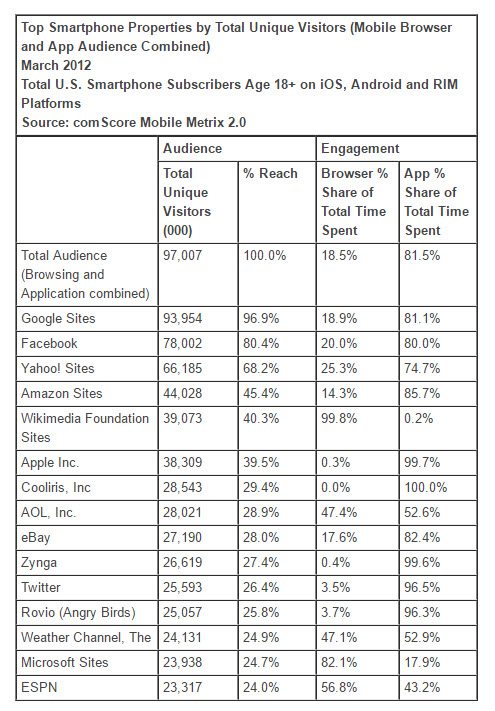With the penetration of mobile devices in our daily lives, every channel is now mobile. As smartphones quickly become the number one web access device, it’s absolutely essential that brands are tapping into this channel to interact with consumers. Ensuring that every advertising strategy and marketing plan must contain a mobile perspective is now more crucial than ever.
Mobile devices are redefining how consumers access information, whether they are on-the-go, at home or work. Translating into tangible results how this vast mobile audience accesses content via their browser, apps and across smartphone platforms are critical concerns. However, while mobile users have been quick to take mobile technology and adopt it into their lifestyles, marketers aren’t even through the halfway yet. There are many challenges for mobile marketers as they’re still learning the tricks of this constantly evolving brave new world.
As per the data compiled by Statista, during 2015 time spent on mobile media surpassed that spent on desktops and 52.7% of the global mobile phone population accessed the internet from their mobile phone. By 2018 this number is expected to rise to above 61%. Mobile marketing strategies must be developed in response to this shift.
Many brands have realized the change in this emerging, marketing landscape but not all succeed in grasping the full potential of the evolution. Developing a marketing plan that truly understands employing the reach of mobile, thus, goes far beyond Mobile shopping. The real issue is how brands use mobile data to understand consumer behaviour and drive reach, engagement and conversion.
Here it seems of value to share some consumer insights that Google pulled together in the mobile path to purchase report.
The report, using surveys and metered data, puts forward five key findings which have implications for advertisers:
Consumers are spending time researching on their smartphones (15+ hours a week),
Their research starts with a search engine (vs. a mobile site or app),
Proximity is important (69% expect businesses to be within five miles of their location),
Immediacy is key (more than half want to purchase within the hour)
Mobile influences their purchase decisions (93% go on to buy).
In an interesting facts & stats study shared by the CMO Council, following significant consumer behaviours have been brought to light:
79% of smartphone owners use apps every day.
Consumers spend 86% of their online time on a mobile app, rather than on the Internet.
78% of smartphone users access a retail site via a mobile app. These people want on-the-go, targeted information with minimal data use that a mobile app provides. 44% of tablet users accessed a retail site via a mobile app.
44% of consumers say that they would like brands to deliver deals and coupons to their mobile devices.
In an analysis of mobile usage, shared by Smart Insights, the most important point is that apps are what take up most of the consumer’s mobile minutes. 82% of our media time is spent with these mini-applications and it’s only growing.
Now that we’ve discussed the importance of mobile marketing – especially for the mobile-centric brands, consumer trends, potential drive reach; this brings us to the most important juncture: Engagement & Retention.
It is significant to note that while the most popular forms of mobile marketing are mobile websites and mobile applications, building an active user base requires more than just user acquisition. The meaty chunk of marketing is, therefore, not acquiring a user, but having a robust re-engagement emphasis.
Herein lays the real challenge for the mobile marketers:
24% of apps are used precisely one time.
26% of users are active 24-48 hours from the first session (a number which decreases to 13% seven days after the first session).
Only 40% of apps are used more than 11 times.
What do these insights imply?
These insights imply that like any relationship, in order to form a solid bond between the app and the user, you need to stay in touch and nurture the relationship. It is all about generating an experience that keeps users coming back for more, and more, and even more.
As is obvious, mobile marketing has had a bit of a leg up on its counterparts when it comes to engagement.
Engagement, especially sustained engagement, matters. In fact, sustained engagement is now considered to be an incredibly important benchmark of success when it comes to mobile marketing campaigns.
Taking the liberty to modify Steuart Henderson Britt’s famous quote to stress upon the importance of engagement in your mobile marketing strategy, I’d say:
“Doing mobile marketing without an engaged audience is like winking at a girl in the dark. You know what you are doing but nobody else does.”
Key factors that determine how consumers keep engaged with your marketing campaign through mobile channels are:
- Adapting a Mobile Content Strategy
Marketers aiming to maximize consumer engagement must look into building mobile specific content and campaigns.
Consumers view their apps as reliable sources of information, so the demand for quality content is strong – and getting stronger. As per a Nielsen survey about app consumption habits, 53% of smartphone owners said they download apps for leisure or entertainment, and 68% said they use apps while they’re “bored” or “killing time.” Seven out of every eight minutes that consumers spend on their mobile devices now goes to apps.
Apps, hence, make a great means for delivering branded content.
- User Security
With this shift of trend to mobile access and apps, the onus for maintaining consumer security falls severely on app designers. Businesses need to be aware of this shift and put measures in place that protect app users as much as those who purchase through the website. Not ensuring user trust puts brands at risk of losing the trust held by their clients, and eventually losing the client.
- Search Engine Optimization With Visuals
Search engine results now display more than pages. Google is already displaying videos in search results and also running video ads. Other search engines, and social media networking platforms are adding auto-playing video ads and Vines to their search results.
In addition, Mobile searching is becoming more responsive, getting further away from typing and closer to voice recognition-based searching. With such transitions already starting to make inroads, incorporation of mobile-friendly visual media is an urgent need.
- Deep Linking
Marketers for mobile employ deep links in order to patch the disruption of redirection to multiple screens and unnecessary taps. Deep links have long-term memory. They also have the ability to carry data about the user into the app, saving the user time and further enhancing the user experience.
Deep linking reduces friction and enhances the user experience by ensuring a seamless transition which contributes to higher engagement rates.
- Social Sharing
Forrester found that social networking apps account for 14% of all smartphone minutes – more than 25 minutes per day. Incorporating social sharing into your app allows you tap into the inherent appeal of sharing through the mobile device.
Social sharing can also feature prominently as an app’s utility. Through social sharing, an app turns an everyday brand interaction into a brand experience while increasing brand exposure and generating additional downloads, too.
- Push Notifications
Push notifications have a reputation for helping keep users engaged. One study found that apps with push messaging had an 88% higher engagement rate.
According to Kahuna, the average opt-in rate for app push messages on Android and iOS devices is 62%. This creates an opportunity to interact with your app users over time. “Messaging bridges the gap between install and engagement,” the company stated. Brands should prioritize a messaging strategy that highlights app benefits, as well as promotes new app features that users might otherwise overlook.
What’s past is prologue, and as mobile marketing continues to grow in sophistication, there’s a lot we can learn from its evolution. Personalization of user experience developed through in-depth analysis of specific consumer trends can result in a dramatically increased sustained engagement in mobile marketing.





